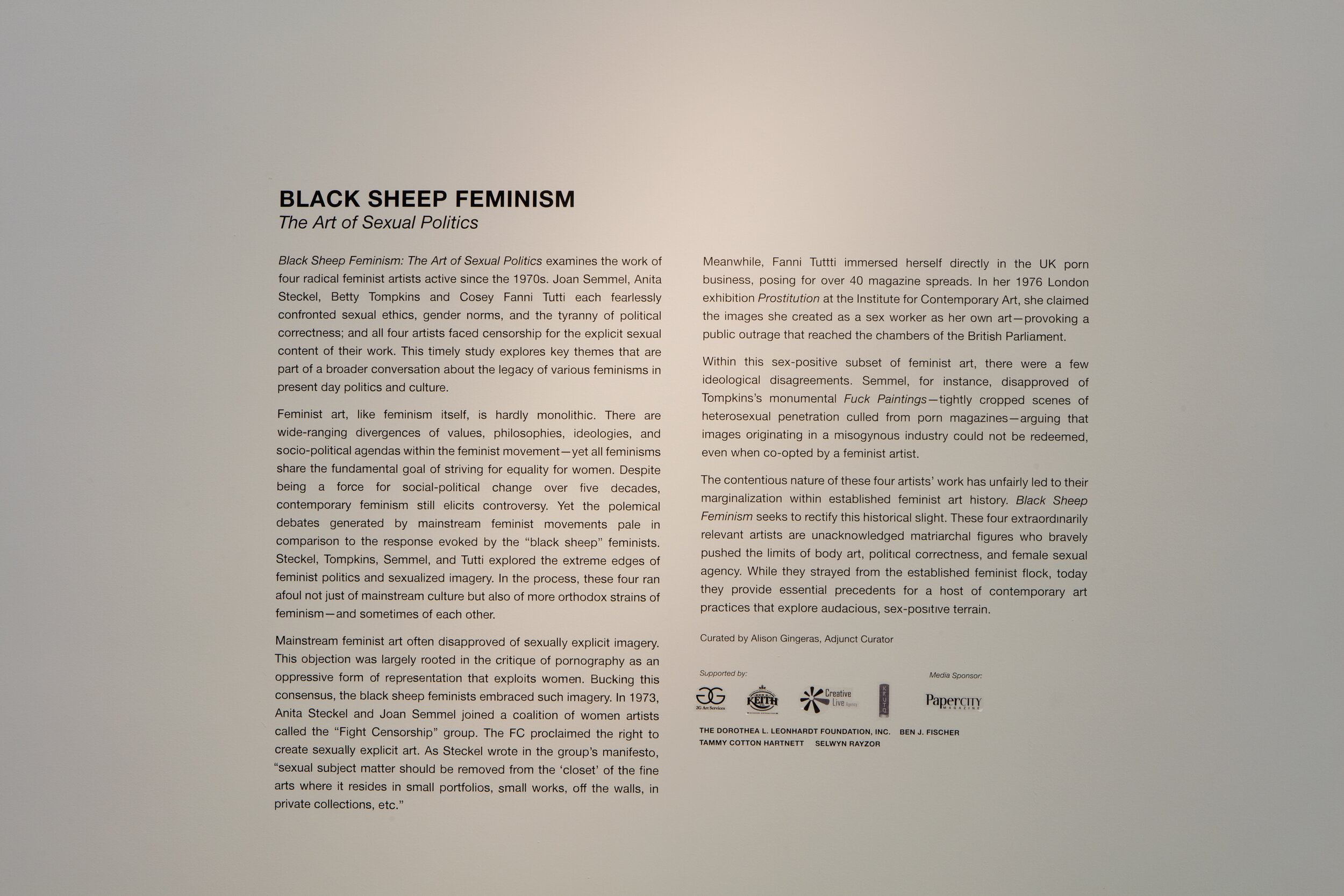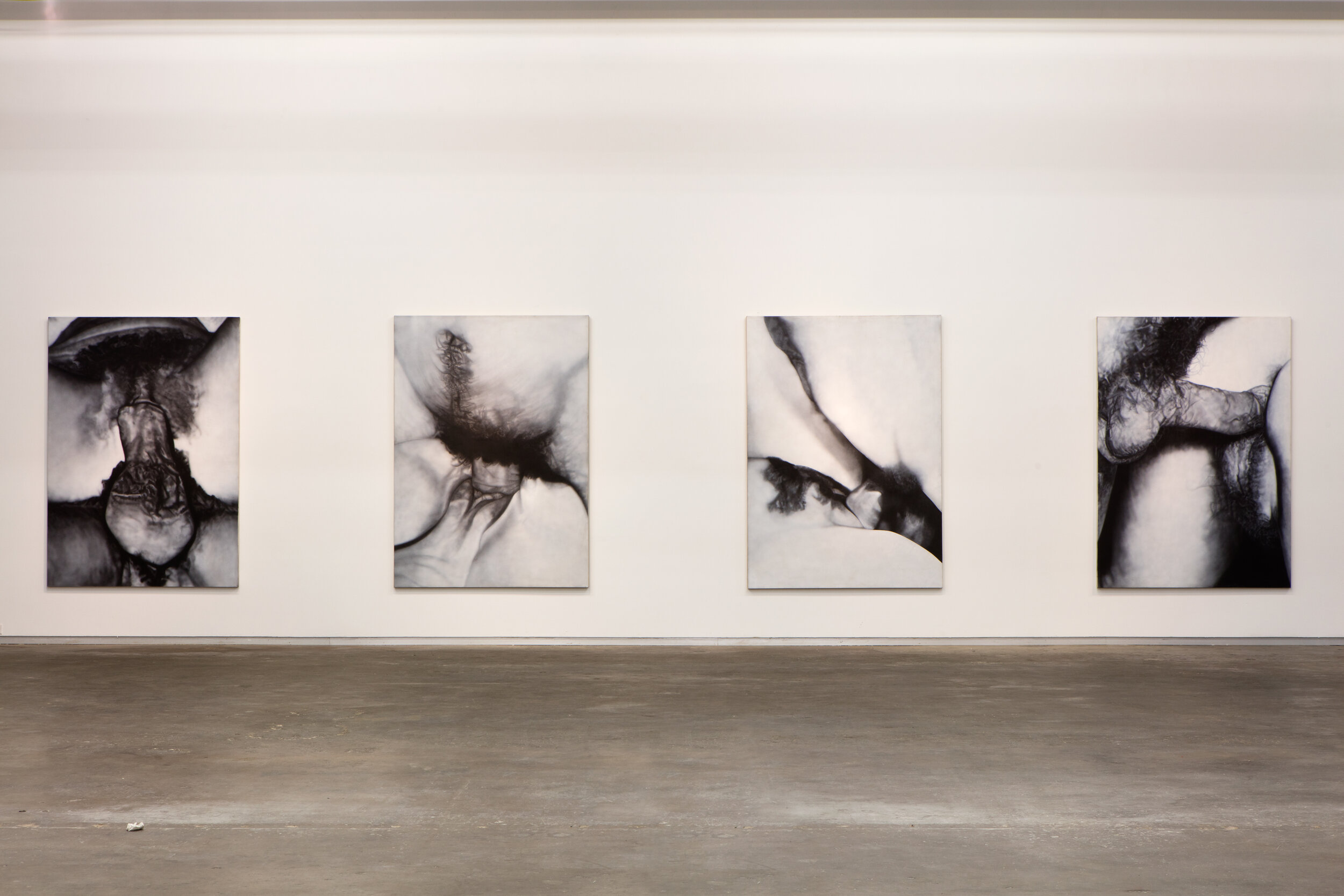black sheep feminism: the art of sexual politics
17 january 2016 - 20 march 2016
curated by adjunct curator alison gingeras
Black Sheep Feminism: The Art of Sexual Politics was my first curatorial project that I organized as Adjunct Curator of Dallas Contemporary.
This show was the culmination of many years of my thinking through my aversion to more mainstream “feminist art”—and it got me thinking about the plurality of the feminist movement, who gets left out of the cannon and the importance of constantly questioning and revising art history.
It was essential to start with this small humorous painting by Anita Steckel because she was the person who organized the “Fight Censorship Group” in the early 1970s and her infamous manifesto sets the tone for the whole exhibition. As Steckel proclaimed in her manifesto, “If the erect penis is not ‘wholesome’ enough to go into museums—it should not be considered ‘wholesome’ enough to go into women.” Another title for this show could have been “Phallic Feminisms” and this hysterically funny little painting not only provocatively up the question of feminists social mores—it also reminds us of the subversive humor that many of these artists exuded in their work.
When I designed the exhibition layout, I felt it was important to have impactful moments when the visitor could be immersed in an artist’s work, but I also wanted there to be dialogue between the four artists—sometimes those artists were at odds with one another.
Here we see three major paintings from Joan Semmel’s erotic series. Semmel was an important vocal member of Anita Steckel’s Fight Censorship Group.
In the early 1970s, Semmel embarked on the explicitly sexual as her signature issue, entwining it with her burgeoning feminist political consciousness. As Semmel explained, “In the past, women’s sexuality had always been used against them. I felt very strongly the sexual issue was crucial in terms of real liberation. So I started to work in the erotic theme, but I was very conscious of it being erotic from a woman’s point of view, rather than from what is normally a man’s point of view.”
Ever since I learned about Betty Tompkin’s incredible struggle to overcome censorship and continue to make her work, she was among my favorite artists. Before I had fully flushed out the ideas for “Black Sheep Feminism,” I had the ambition to show the original series of “Fuck Paintings” that Tompkins began in 1969. I purposefully decided to hang these four seminal pieces from that series at the far wall of the gallery in order to draw the visitor into the space, and also to underscore how the paintings morph from figuration to abstraction depending upon the distance of viewing.
In the 60s, Tompkins’ husband had a clandestine collection of pornographic images that he had amassed since the 1950s. His erotic trove was amassed via mail orders—he had seen advertisements in the back of magazines and had the photographs sent to a P.O. box over the Canadian border (at that time it was then illegal to send obscene materials through the U.S. Postal Service). Tompkins had an epiphany in a fit of frustration—looking at the untapped potential of the illicit iconography of her husband’s collection. Tompkins used these pornographic photographs as the source material for her Fuck Paintings—cropping out all the details but the genitalia. This radical appropriation got Tompkins into a lot of hot water, both with government censors and the community of women artists who could not endorse her use of pornographic found materials.
These three cityscapes by Anita Steckel were a great revelation to me—and I wanted to give them pride of place in the exhibition. While Steckel was a charismatic figure who organized her fellow women artists, she was not really given her due in her lifetime. These three paintings underscore the way Steckel deployed humor entwined with biting political critique in her work.
Her monumental New York Skyline paintings (1970) and Giant Women series (1969-72) caused particular uproar when she showed them at Rockland College museum and were nearly censored by the school administration. While the depictions were often cartoonish and quite whimsical in execution, these works were populated with erect penises and defiant nude women against a backdrop of phallic skyscrapers of Gotham. As art historian Rachel Middleman has summarized, these works “navigated the difficult territory in representation between the pleasure of eroticism and the critique of patriarchal power,” thus testing the limits of political speech and obscenity regulations of the time. Steckel’s show received the moral support of numerous publications and institutions, and while she was blacklisted from teaching for over two decades, this attempt to censor her work had been the catalyst for Fight Censorship Group.
When I was thinking through the Black Sheep Feminist conceit, I was shocked to learn that the British artist Cosey Fanni Tutti was never the subject of a solo presentation in an American institution—at best, she was included in group shows such as the groundbreaking “WACK: Art and the Feminist Revolution.” As such, I hoped to show Fanni Tutti’s work in a fairly comprehensive manner—and chose to give her almost the entirety of the gallery’s longest wall to so that viewers could run the gamut of her career as they walked through the space.
Long before the flames of the feminist culture wars of the 1980s ignited over fractious issues such as pornography and the politics of erotic representation, Cosey Fanni Tutti navigated this thorny landscape through her art practice. Perhaps better known in the experimental music community as a cofounder of the groundbreaking band Throbbing Gristle (active from 1973 to the early 80s), Fanni Tutti lead a double life in the same period working as a model and performer in the porn industry in the UK. Without framing her participation under the relatively “safe cover” of her identity as an artist, Fanni Tutti was completely immersed in the sex business throughout most of the 1970s posing in more than forty hard-core porn magazines, as well as films and live performances. Transgressing the conventions of feminist body and performative art practices of the era, Fanni Tutti’s full assimilation in the world of sex work was profoundly radical—well beyond the discursive posturing of many of her peers.
In 1976, Fanni Tutti officially “came out” as an artist on the occasion of her exhibition Prostitution at London’s Institute of Contemporary Art. The hardcore spreads she had made as a sex worker were proclaimed as her own artistic production—she dubbed them her “magazine actions,” and stated on the exhibition’s poster-cum-manifesto, “Cosey has appeared in 40 magazines now as deliberate policy...Different ways of seeing and using Cosey with her consent, produced by people unaware of her reasons, as a woman and an artist.” This declaration of authorship and affirmation of her agency forms the conceptual crux of Fanni Tutti’s practice. As Fanni Tutti later explained, “My intention was both to infiltrate the sex market to create [and purchase] my own image … and to gain firsthand experience of being a genuine participant in the genre … I couldn’t adopt the approach of a voyeuristic or analytical artist viewing from the outside … What was required was for me to become ‘one of the girls.’
While all four artists in Black Sheep Feminism shared explicit subject matter and the experience of censorship, there were other narratives between these four artists. Semmel and Steckel were part of the Fight Censorship Group and shared a circle of artist colleagues. Fanni Tutti was an outlier, working in London without knowledge of the New York artists like Steckel and the FC group. Tompkins too was an outlier in New York—she realized only retroactively decades after that the fact that she was actively excluded from feminist artist groups because of her use of pornographic source imagery. Semmel in particular objected to Tompkins’ work and I was interesting in subtly alluding to their opposing views in the exhibition—purposefully hanging their work in close proximity in the show so as to suggest this ideological divide that caused a schism between branches of radical feminism in the 70s.
Political correctness and political intention were at the heart of the bifurcation of Semmel and Tompkins career paths. Semmel insisted on her interest in eroticism as being in alignment with the new feminist zeitgeist. At every possible turn, Semmel insisted on her work as depicting “the female perspective” and her refusal of found imagery, unlike Tompkins’ deployment of pornographic sources, she claimed as a kind of ethical insurance policy that her work did not involve any form of sexual exploitation or sex work. She even went so far as to carefully underline that the models she first drew, and later photographed, were never paid—she explains that she and a group of other women artists had met a male exhibitionist who volunteered to pose, and sometimes copulate, with his female partners for their artistic study. Semmel began to compile a history of women artists making erotic work in this period.
Betty Tompkins’ Fuck Paintings were omitted from the manuscript of Semmel’s A New Eros, despite the obvious overlap in subject matter. While Semmel was clearly aware of Tompkins’ practice when she was assembling her book, Tompkins didn’t make the cut because her work was seen as crossing a red line: Semmel objected to Tompkins’s appropriation of her source images from pornography on the grounds that they originated in an exploitative, misogynous industry and thus could not be redeemed despite their cooption by a woman artist. Tompkins’ deliberate exclusion also extended to the feminist artistic and political groups that Semmel was participated in and whose membership played a large role in the professional opportunities in the New York art scene of the 1970s. “I was an accidental dissedent,” Tompkins explained with over fifty years of hindsight. “Being excluded from the feminist art movement gave me a lot of freedom. I read the books and articles, but I was free to pick and choose. I wasn’t subject to any social pressure. I am better off for it. Artists like Joan Semmel had tied their work to theory. I had grown up around leftist politics, and grew up with theory. I saw the arguments and the divisions. It didn’t help anyone.”







